| 2. Sustainable Educating and Developing (SED) |
| |
| Do we have to mention the number of truants and untimely school leavers, about the number of relapses of juvenile delinquents, about the influences of aggression and porn via internet, about the problems of foreign youngsters, or do we know? Is there no reason to investigate and register alone but do we have to do something, do it.. do what we know that we have to do: Sustainable Educating and Developing! |
| |
Sustainable Educating and Developing (SED) is an approach which uses insights and strategies on the basis of ecological insights (linkedness) and high values and intentions (such as wellbeing and involvement) by which the quality of interactions can be improved to the benefit of developments which can make man and mankind destine to ‘exist longer.’ It is a constructive way of thinking and working. The ecological insights give insight in the coherence of man with the other person and his environment. By DuED on the one hand you get a view on the complex reality and on the other hand this complexity is not talked about in a simple way. |
| |
| |
| Upbringing, education and durability |
| Upbringing is of all times. Developing too. Nevertheless current educational systems do not have such a long history and durability as a theme has only recently become topical. Bringing up is according to van Dale ‘raising and forming.’ At developing one can read ‘expanding, improving, making grow’ and durability is ‘suitable, destined to exist for a long time.’ If we want to raise children in a way in which they can grow in order to exist for a long time, in short if we want to educate and develop them durably, then we will have to change course. The durability of the earth is under pressure. Education and development are likewise under pressure. The durability problem of the earth cannot be explained and solved simply. But the fact that we together are not able to create hopeful perspectives becomes visible in van Dale’s definition of education: ‘systematically transmitting knowledge and skills by qualified teachers.’ ‘Transmitting’ is ‘displacing’ and evokes the impression that the qualified teacher displaces his knowledge to the pupil. It does not work like that. If we want to place counselling at the service of an upbringing which wants to advance the durability in this world, then something else is needed but ‘transmitting.’ |
| |
| |
| The inconvenient truth |
| In the meantime everybody knows the images of melting glaciers, a rising sea-level and climate changes from Al Gore’s ‘An Inconvenient Truth’. The film and the book with the same title make an urgent appeal on the world to reduce the emission on CO2 drastically. Many have left the cinema while sighing. Is the problem too big and ‘cannot you do anything about it any way’ or is it high time that everybody takes his responsibility? |
| |
In ‘The inconvenient truth’ Al Gore warns against the climatic problems which are possibly in store for us.
‘The inconvenient truth’ is probably we will have to fix it ourselves. |
| |
| Many people who are occupy themselves with technological durability issues use the principle ‘from cradle to cradle.’ The principle is that all elements and materials must be used again and must not be lost. A synthetic product must be completely recyclable . ‘Waste is food.’ Away from the ‘from cradle to grave’ principle. Away with the waste and the loss of raw materials. |
| Entrepreneurs see more and more durable chances. From energy smart bulbs to completely recyclable chairs, from wind and solar energy to energy generating dance-floors. |
| |
| |
| Sustainable Educating and Developing |
| Unfortunately the human path of life cannot be bent to ‘from cradle to cradle.’ We are on our way from the cradle to the grave and our recyclability is limited. Nevertheless it fits a refined civilization to base its intercourse with each other and the inheritance to a next generation on high values. Yet, the upbringing we give each other, to children, in companies, in communities and institutions has most chance of a durable character if common values are endorsed. The way in which we are raising and forming each other becomes visible in our acting. And in our acting we represent our values. |
| |
| Upbringing and developing are indissolubly linked. Interactions in institutions where children are guided always have a pedagogic character. It is sometimes conscious when values and intentions are made explicit and sometimes it is subconscious. In order to make a development durable in the sense of ‘intended to exist for a long time’ something else is needed from transmitting pure knowledge. If you want the next generation to be destined to exist for a long time there must be attention for the generation itself and for the earth on which this generation will have to live. |
| |
| The media report about interpersonal problems daily. The durable human perspective knows an educational and development model that has knowledge of the past and interest in the future; it has esteem for all exertions which were constructive in another time but it builds together with the next generation on a world we take pleasure in and we want to be responsible for. |
| |
| |
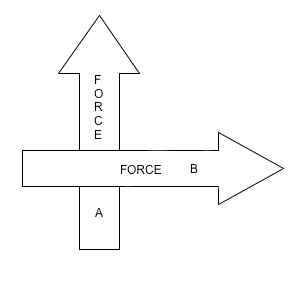 |
|
DuED is ‘accounting for the other side’ |
| Developments are most successful if ‘the other side can still be accounted for.’ When making decisions and determining policies one often has to choose: are we going left or right? The direction is sometimes clear and pleasant for all participants and it sometimes leads to resistance. It is important if you go left that you can still account for going right. If institutions choose for working more demand directed then they will have to account for the fact that the supply is okay and the other way round. Not the choice determines the success but the insight in the resistance it evokes and the possibilities you have to deal with it. The coach who likes to teach will have to be able to point out how it enters children. The coach that gives much autonomy will have to show what it learnt. Without that ‘other side’ there is no connection, no relationship, no interaction and there can be no DuED. |
| DuED is living the highest values |
| Ecologically seen making connections and creating networks is crucial. In order to survive it is necessary to have a good relationship with oneself and one’s environment. It is important that you determine priorities with reference to the values and intentions of your institution or organisation. From that point you can get a common perspective in view. |
| |
| In this respect ecological insights (linkedness) are of a higher order than values and intentions (wellbeing and involvement). The norms and forms are of an even lower order. In other words it is not about how you are doing things, but if the process does serve the highest values. There are a thousand ways to become happy, to develop well and to create linkedness with others. Respecting different forms of expression does justice to man’s uniqueness. |
| |
| Developments are most successful if ‘the other side can still be accounted for.’ When making decisions and determining policies one often has to choose: are we going left or right? The direction is sometimes clear and pleasant for all participants and it sometimes leads to resistance. It is important if you go left that you can still account for going right. If institutions choose for working more demand directed then they will have to account for the fact that the supply is okay and the other way round. Not the choice determines the success but the insight in the resistance it evokes and the possibilities you have to deal with it. The coach who likes to teach will have to be able to point out how it enters children. The coach that gives much autonomy will have to show what it learnt. Without that ‘other side’ there is no connection, no relationship, no interaction and there can be no DuED. |
| |
| |
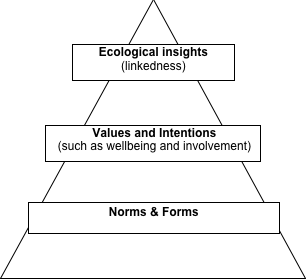 |
|
The DuED pyramid |
Ecological insights give an image of man and his environment. Linkedness is essential to make interactions run successfully. Delinkedness leads to estrangement, inhibitions and delinquency.
Values and intentions give direction, language and perspective.
Norms and forms are inferior and should serve the (common) values and intentions.
A growing number of TV programmes is based on selection. Much coaching of children at school at sports clubs etc. knows the same mechanism. But is not the selection that links us. It is linkedness that selects who you can go further with! It is ‘of vital importance’ to word linkedness as highest value. A branch that has been cut does not grow anymore. A child that is rejected and bullied will live on, but will express the burdened impressions again. In the meantime we know from many examples that one person can disrupt a complete society. Why should we continue excluding persons or communities. We do know what happens when ‘they’ come back….. We may exclude nobody! |
| |
| |
| DuED is constructive |
| Though there is no recipe for educating and developing durably there still is a final criterion. Processes must be constructive by nature. This does not mean that it always passes pleasantly or that there would not be any conflicts. On the contrary: it is sometimes necessary that an open and honest battle is entered. It is sometimes necessary to delink in order to enter new connections. But where developments become destructive delinkedness is unavoidable and chances of durability are fading. |
| |
| |
| DuED can be measured with ‘two circles’ |
| When institutions or organisations have determined their intentions and values, you can look per employee what the personal filling of these intentions and values is. Everyone puts different accents from his own biography. Experiences determine the specific filling. (“I may not look like the one that I hate so much”. or “I want to do what I learnt from my great example.”) Counsellors are authentic if their own experiences are tuned to the values they are propagating. Others must feel that it ‘is right.’ The inside and the outside have to tell the same story. |
| |
| That is also true for the institution or the organisation: the intentions and values that have been determined must be ‘told back’ by the stories and behaviour of everyone who is involved. In the counselling of children the circle is complete when they in their own words and behaviour ‘tell back’ the intentions of their counsellors. |
| |
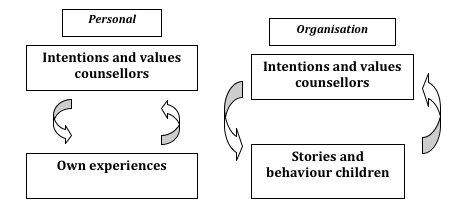 |
The DuED circle |
| Durability only then gets a chance if intentions and values are visible and audible in the behaviour and stories of all participants. |
|
| |
If a child tells things itself…
At a school which thought it important that children learnt to make their own choices and could be responsible for the freedom they got a six-year-old child told:
“Here you may choose a lot yourself. That is fine because you can keep working well and yet you get help if it is necessary.” But does that mean that you always get your own way?
“No, of course not. Because otherwise other children could not choose anything. Yet there are all of us!” |
| |
Linking also with delinquents
A behaviourally disturbed is exported to a juvenile prison while heavily escorted. The car is driven backward against the unit where the boy should stay. When the director opened the door of the car he saw the boy was in a dog’s cage. While being astonished he asked the policemen why the boy was in the cage. They answered that the boy was too dangerous and that this means was available. While the director opened the door of the cage, he was admonishing the policemen. He asked if they had gone completely crazy to lock up a human being in a dog’s cage. While he freed the boy, he warned the policemen that this had been the very last time that a human being was delivered in such an inhuman way. The director walked into the corridor with the boy and said that he might be raving mad or dangerous to life but that this should have been the last time that he was not treated respectably.
Later the director told that the boy was still ‘behaviourally disturbed’ but that their relationship had a good basis from which they were able to associate with each other. |
| |
| |
| Conceptualising |
| By making your intentions and values of a higher order than the norms and forms you can get further into the direction of which the end has not been determined but at which you know that you ‘are on course’. Not a document or a policy document is sacred in this but the process that could be called conceptualising. Conceptualising is ‘making round.’ Conceptualising is a verb, you must do it! Testing your experiences by your values and discuss your values with reference to your experiences. If counsellors and children represent the commonly shared values in their stories and behaviour it is possible to keep supporting each other in this permanently. |
| |
Rens, a child in group 6, got stuck at a traditional school and looked with his parents for a ‘more pleasant place.’ After he had been at the new school for some time he was asked about the teacher at his former school.
“Yes, the teacher always had one pupil that he slated and one pupil that he put on a throne.”
And where were you?
“Yes, I was at the bottom of the list. It is different here. Everybody is equal here: with a new week or a new week the slate is completely clean again.” |
| |
| Rens ‘is telling’ that educating is possible from cradle to cradle. He says that we can start every day here and now. And no matter how well we all think to know, it is not possible without the dialogue with whom it concerns. There is no reason not to start as early as possible. If we want to survive in the Netherlands with our innovative power then not a drop of talent may be wasted. That is reason enough to start durable education and development here and now! |
| |
| Sustainable Educating and Developing means starting as early as possible and ending as late as possible: Learning a Life Long! |
| |
| Herman Wijffels, Dutch trustee of the World Bank says in The Telegraaf on 31 December 2007: “ The relaxation of the law of dismissal would be attended by a right to learning a life long. In this way everybody would always be able to keep developing. In this way the Netherlands can keep measuring their strength against our international competitors.” |
| |
| |
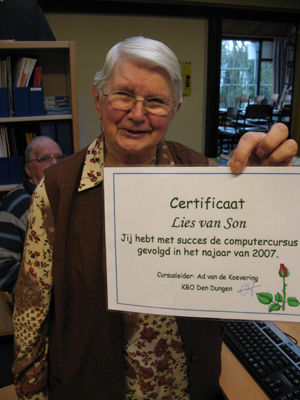 |
|
Talking about learning a life long..
A woman of 70 years old got a certificate for a computer course at an organization for the elderly. Proudly she received the plasticized document and said to the teacher of the course: “Now I am going to phone my children and ask if they are coming to have a look at my report. And then I will ask money for it. They used to that with me.” |
| |
| |
| Anti-leak or learning with pleasure |
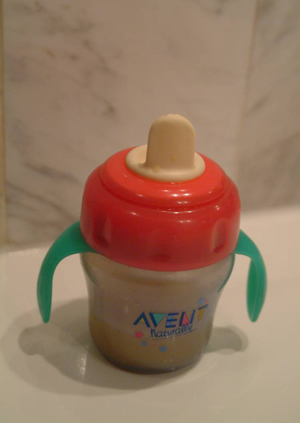 |
|
For what age is this anti-leak beaker intended? Exactly for people between twenty and forty! |
| |
| On the internet anti-leak beakers are on offer. One can read: “The child can learn to drink in a proper way without soiling the house. This convenient anti-leak beaker does not drip when shaken or fallen. By means of the ergonomically formed grips the child can easily hold the beaker and learn to drink itself.” |
| |
| Under the title ‘sucking joy and drinking utensils’ even interactive product tests are held. Many very enthusiastic reactions are being alternated with a few critical sounds, which is called ‘disillusioning’ “Every child likes drinking from a normal beaker (glass) or from a carton with a straw as soon as it is not fed by breast or bottle anymore. Give it time to learn this without thinking of all kinds of difficult solutions which should stop the spilling while practicing. Just putting on a bib, make it sit still, if need be with some old papers under the baby chair. Then the child will drink without spilling in no time.” |
| |
I underline the critical sound. These so-called tricks are for parents, not for children! In a centre for young children in Sweden that I visited, from the moment that they are able to sit children are eating their dinner without supervisor. They taste, select and communicate. Children seem able to eat independently and together at a very early age. They get their own plate, take it away at the end and clean it themselves. After that the counselors clean the room. The counselors have to clean more for the youngest ones. But very soon the children do it themselves.
Helping to cook, laying tables, eating deliciously, doing the washing-up and clearing the table is not learnt by children who sit down to the laid tables. |
| |
| Cutting, mixing, ‘not too big and not too small bites’ and no spilling are not learnt by children that are lying in front of the television with an ergonomic beaker. |
| |
| Esteem for the cook and the food is not ergonomics. And those relationships are reinforced if time is taken with attention for interactions. We can adapt everything to children. But if we want them to adapt then they must be able to experience the resistances with their bodies and all their senses. Safely, but as early as possible. Why would you do it later? |
| |
The monkeys and the bananas
In an experiment ten monkeys are put into a cage with in the middle a few blocks and high on top of them a bunch of bananas. By putting the blocks on top of each other the monkeys can reach the bananas. Very quickly the monkey take the blocks, pile them and want to climb onto them to be able to get the bananas. At that moment all monkeys are being sprayed with water. Since monkeys absolutely hate getting wet, all monkeys are recoiling. After a short break one monkey is trying. The monkeys are sprayed wet again. Then they have become wiser: they stay away from the blocks and the bananas.
Then one of the monkeys is taken out of the cage and a new monkey is brought inside. It has not seen anything of this experiment. It is looking on for a while. You see its glance often goes to the bananas. After a while it approaches the blocks, piles them one onto the other. But before it can reach for the bananas all other monkeys are dashing onto it to pull it away from it. They are beating it, so it understands that is not the intention
Monkey number two is being changed. It is the same story: the new monkey looks and approaches the blocks and all monkeys are pulling it away in order to not being sprayed wet again. But what is interesting: the monkey that was changed before which has never been sprayed wet, participates equally strongly!
In course of time all monkeys have been changed. None of the monkeys knows why but they do what they have learnt from the members of the same species. They are beating and do not climb to the bananas.
Are you beating or picking bananas?
Or are you also afraid of being sprayed wet? |
| |
| |




